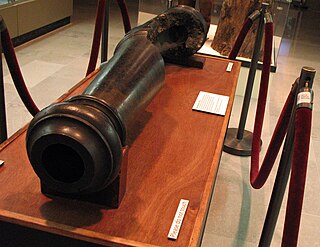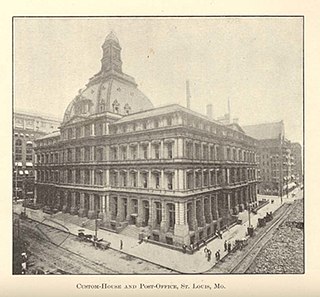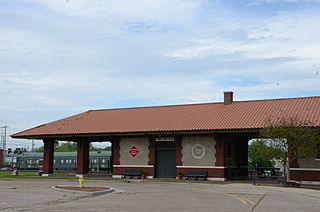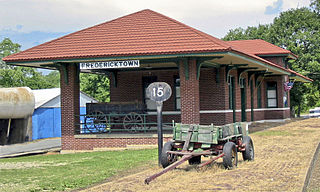
Fredericktown is a city in and the county seat of Madison County, Missouri, United States, in the northeastern foothills of the St. Francois Mountains. The population was 4,429 at the 2020 census. The city is surrounded on three sides by the easternmost parcel of the Mark Twain National Forest.

The Northwest Railway Museum (NRM) is a railroad museum in Snoqualmie, King County, Washington. It incorporates a heritage railway, historic depot, exhibit hall, library, and collection care center, and serves more than 130,000 visitors per year.

The Liberty Arsenal, known by Federal authorities as the Missouri Depot was a United States Army arsenal at Liberty, Missouri in Clay County, Missouri. The depot was seized twice by Southern partisans, once during the Kansas troubles in 1855, and again shortly after the outbreak of the American Civil War. It was located generally west of the junction of Missouri Route 291 and old 210 Highway.

Endion station is a former train station in Duluth, Minnesota, United States. It was built in 1899 to serve the Endion neighborhood but was relocated to Canal Park in 1986 to make way for expansion of Interstate 35. Passenger service through the station had ceased in 1961 and freight service in 1978.

Poplar Bluff station is a historic train station in Poplar Bluff, Missouri, United States, served by Amtrak, the national railroad passenger system.
St. Louis, Iron Mountain and Southern Railroad Depot may refer to

The St. Louis County Depot is a historic railroad station in Duluth, Minnesota, United States. It was built as a union station in 1892, serving seven railroads at its peak. Rail service ceased in 1969 and the building was threatened with demolition until it reopened in 1973 as St. Louis County Heritage & Arts Center . Train service also resumed from 1974 to 1985, by Amtrak.

The U.S. Custom House and Post Office is a court house at 815 Olive Street in downtown St. Louis, Missouri.

Louis Singleton Curtiss was a Canadian-born American architect. Notable as a pioneer of the curtain wall design, he was once described as "the Frank Lloyd Wright of Kansas City". In his career, he designed more than 200 buildings, though not all were realized. There are approximately 30 examples of his work still extant in Kansas City, Missouri where Curtiss spent his career, including his best known design, the Boley Clothing Company Building. Other notable works can be found throughout the American midwest.

Kansas City Union Station is a union station opened in 1914, serving Kansas City, Missouri, and the surrounding metropolitan area. It replaced a small Union Depot from 1878. Union Station served a peak annual traffic of more than 670,000 passengers in 1945 at the end of World War II, quickly declined in the 1950s, and was closed in 1985.

The Cotton Belt Freight Depot is a former freight depot of the St. Louis Southwestern Railway in the Near North Riverfront neighborhood of St. Louis, Missouri. It was listed on the U.S. National Register of Historic Places in 2004 and named "Best Old Building" by the Riverfront Times, a weekly newspaper in St. Louis.

Hope station is a passenger rail station in Hope, Arkansas. The station is located on Amtrak's Texas Eagle line. Trains run daily between Chicago, Illinois, and San Antonio, Texas, and continue to Los Angeles, California, 2,728 miles (4,390 km) total, three days a week.

The Glenwood Iron Mountain Railroad Depot is a historic train station building in Glenwood, Arkansas. It is a single-story wood-frame structure, located just west of the point were U.S. Route 70 crosses the Union Pacific tracks. It was built c. 1910 by the St. Louis, Iron Mountain and Southern Railway, and used by that railroad and its successor, the Missouri Pacific Railroad until 1969. It was sold that year and relocated out of town for use as a hay barn. The city purchased the building in 1995, and returned it to a location a short way south of its original location, which is now occupied by a major road intersection.

The Russellville, Arkansas Missouri Pacific Depot is a historic passenger railroad station located just north of the intersection of South Denver Avenue and West C Street. It is a long rectangular single-story masonry building, finished in brick and stucco and covered by a hip roof with supporting Italianate brackets, designed in a Mediterranean style that was popular when it was built. At both ends, the roof extends beyond the structure to form a sheltered porch supported by square brick columns. A telegrapher's booth projects from the building's north (track-facing) side. An open breezeway separates the passenger and express freight sections of the depot. Three brick chimneys rise through the ridge line, two above the passenger section to the east and one above the freight section to the west. Completed in February 1917, it is typical of many railroad depots of that period; its original tile roof has been replaced by composition shingles.
E. M. Tucker was an American architect of St. Louis, Missouri, who worked for the Missouri Pacific Railroad.

Fredericktown Missouri Pacific Railroad Depot, also known as the Fredericktown Depot, is a historic train station located at Fredericktown, Madison County, Missouri. It was built in 1917 by the St. Louis, Iron Mountain and Southern Railway, later Missouri Pacific Railroad. It is a one-story rectangular brick building with a low-pitched red tile hipped roof with Prairie School and Bungalow / American Craftsman style influences. It measures 22 feet by 128 feet, and features widely overhanging eaves supported by large curvilinear brackets and a projecting dispatcher's bay. In 1917–1918, the new Fredericktown Missouri Pacific Depot took over passenger service, while freight continued to be handled by the original St. Louis, Iron Mountain and Southern Railroad Depot. Passenger service to Fredericktown was discontinued in 1972 and the building subsequently used for commercial enterprises.
St. Louis, Iron Mountain and Southern Railroad Depot is a historic train station located at Fredericktown, Madison County, Missouri. It was built in 1869 and expanded about 1908 by the St. Louis, Iron Mountain and Southern Railway. It is a one-story, rectangular wood-frame building with a gable roof on short wood piers. The original rectangular section was approximately 25 feet by 65 feet and the addition extended the building approximately 30 feet. In 1917–1918, the new Fredericktown Missouri Pacific Railroad Depot took over passenger service, while freight continued to be handled by the original depot.
Marshall Hotel, also known as the Dunn Hotel, is a historic American hotel building located at Sikeston, Scott County, Missouri. It was built in 1910, and is a three-story, red brick commercial building with a shed roof. It measures 70 feet by 120 feet and features a cast iron storefront and segmental arched windows.

The Missouri Lumber and Mining Company (MLM) was a large timber corporation with headquarters and primary operations in southeast Missouri. The company was formed by Pennsylvania lumbermen who were eager to exploit the untapped timber resources of the Missouri Ozarks to supply lumber, primarily used in construction, to meet the demand of U.S. westward expansion. Its primary operations were centered in Grandin, a company town it built starting c. 1888. The lumber mill there grew to be the largest in the country at the turn of the century and Grandin's population peaked around 2,500 to 3,000. As the timber resources were exhausted, the company had to abandon Grandin around 1910. It continued timber harvesting in other parts of Missouri for another decade. While some of the buildings in Grandin were relocated, many of the remaining buildings were listed on the National Register of Historic Places in 1980 as part of the state's historic preservation plan which considered the MLM a significant technological and economic contributor to Missouri.



















